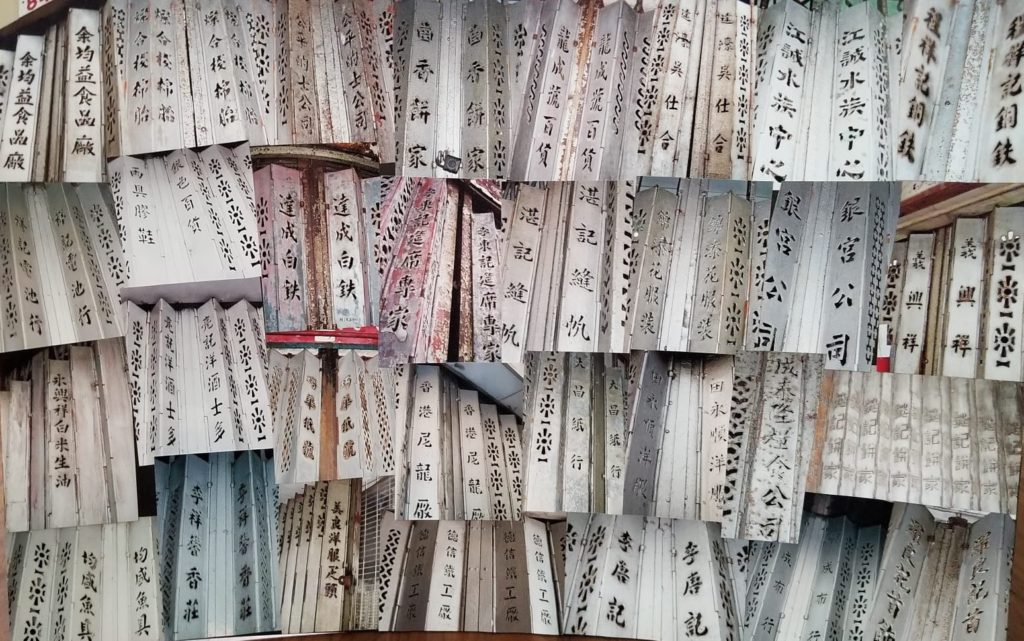(photo credit: Freda Chan)
A friend of Madeleine’s who is a wonderful photographer living in Hong Kong shared a most fascinating montage of shots taken of “steel-folding-door” store-fronts of traditional old-style stalls in the city – if you look carefully you can see the names of cake shops, furniture shops, grocery stalls, fishing tool store, tailor’s store, textiles shop, and many others.
And yes a good look at these photos inevitably brings us to thoughts about MTR and the role it has played in Hong Kong.
How so?
Well, this photographer friend tells us that these photos were taken mostly 10 to 12 years ago in some of the “older” districts in Hong Kong, including To Kwa Wan (on Kowloon side), Sai Ying Pun and Western District (both on Hong Kong island side), as well as Peng Chau and Cheung Chau (2 outlying islands) and areas what used to be considered “rural” and “farming” areas (like Kam Sheung Road). Some were also taken in “older” districts in Macau too, for example, around the Rua de Cinco de Outubro (十月初五日街 in Chinese, or translated as “October 5th Road”).
It is Hong Kong’s famous MTR line (the equivalent of London’s Underground and New York’s Subway) that has contributed to the disappearance of these old-style “mom and pop” stalls as a result of urbanisation and gentrification.
Indeed, the MTR has grown as Hong Kong and Hong Kongers have grown. The MTR company is not only a “large-cap” listed company that is one of the 50 constituents in the Hang Seng Index, one of the world’s most important benchmark stock indices, it also enjoys a rather entrenched position in Hong Kong society – every single citizen uses it! Famously efficient too and with its first line only opened in the late 1970s, the MTR has since become part of the fabric in the daily lives of a majority of the city’s population.
And travelers who wish to see these changes must go visit some of the districts going through this gentrification today and are still a mix between the “old” and the “new” even if moving to the new quite rapidly. One of these districts is Sai Ying Pun, one of Madeleine’s favourites.
Sai Ying Pun is very much a case in point, perhaps where the changes are most visible (some say irksome) and probably partly because of its proximity to Central: the years leading up to the new station opening already set in train some significant changes with old-style restaurants disappearing seemingly by the week (even if the new restaurants are all really quite wonderful – just wander along High Street or Third Street and you will stumble onto many interesting places), the opening of over 10 hotels, as well as a very noticeable influx of trendy bars and restaurants. Thankfully, while this is all going on, not all “old” things have disappeared, with some old stalwarts standing tall and defiant, unscathed and unperturbed in spite of it all, and “old” and “sleepy” corners that for the moment have remained “un-touched”; two of our favourites include Books & Co (10 Park Road), a cosy (and still rather sleepy and peaceful) bookshop that stocks quite a range of secondhand books (as well as new books) and with a couple of tables and chairs where bookworms can relax with a coffee or tea or escape the real world for a little while, as well as that old-timers’ favourite Chinese soup dessert place, Yuen Kee Dessert (on the 32 Centre Street site since 1855!). And then there are some interesting new arrivals too: Live Zero (20 High Street and also here), the city’s first zero-waste shop where all supplies are sold packaging-free, amongst others. And then there’s this place called Locofama, a tiny place with both indoor and beautifully secluded outdoor seating (on Fuk San Lane – warning: difficult to find!) that on a fine cool spring or autumn Sunday afternoon is perfect for a long linger even if the choice of drinks or eats (all organic and very much about locally-sourced and healthy eating) is small.
But of course public transport is critically important to such a densely populated city; it was after a “lull” of more than 10 years that these 9 new MTR stations were opened, in quick succession, and the years of anticipation were brought to an end.
In the last few years, Hong Kongers were treated to a significant extension of the MTR network in quick succession: winter 2014 and spring 2015 saw the westward extension of the “Island Line” in the progressive opening of 3 new stations (Sai Ying Pun, HKU and Kennedy Town), while the autumn of 2016 saw the long-awaited opening of the Ho Man Tin and Whampoa stations that represent an inner-Kowloon extension of the Kwun Tong line to the area near the “old” Kai Tak airport area, and then a few days after Christmas the same year came the opening of the “South Island” line with 4 new stations including the now very well-established residential area on the southern island called Ap Lei Chau that is just off from Aberdeen waterfront.
“Old” Hong Kong, “new” Hong Kong, even newer Hong Kong. The city is a great mix still – just go and witness changes happening right in front of your eyes (and of course you can also learn more about and experience the desire for political change represented by the “yellow umbrella movement”)!





